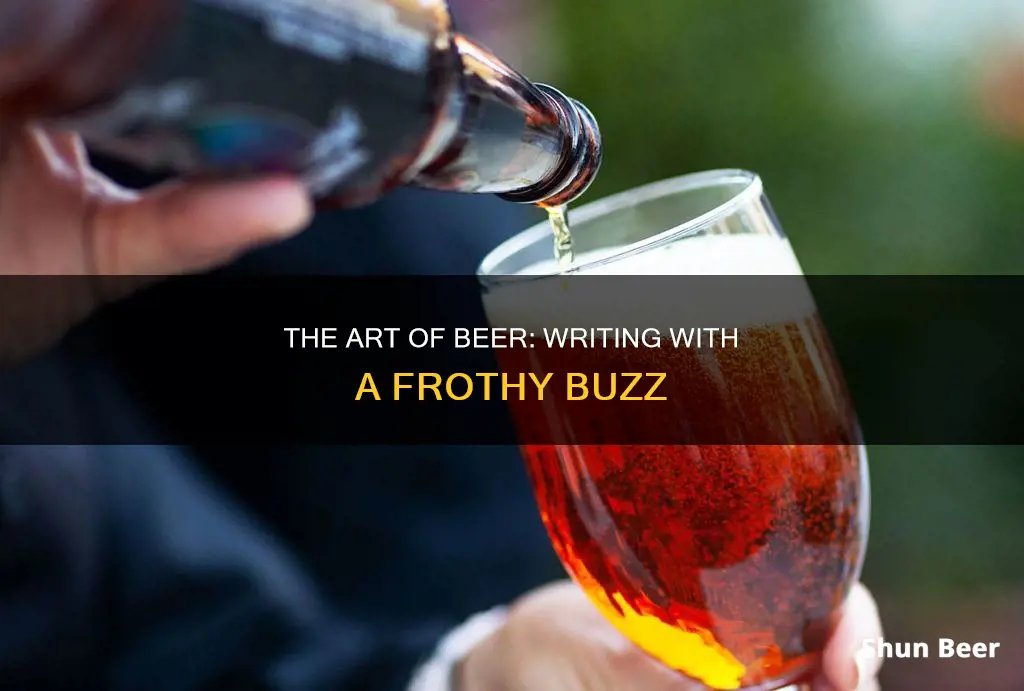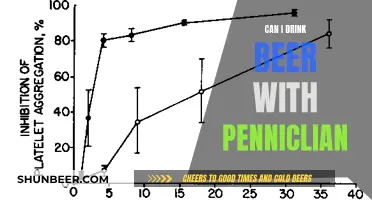
Drinking beer is an age-old pastime, but how do you describe the experience of drinking it? The beer scene has seen remarkable growth, with a vast array of options now available, from the bold bitterness of West Coast IPAs to the explosion of tropical and citrusy Hazy IPAs. Describing the drinking experience can be a fun and flavourful adventure, and there are many ways to go about it.
One way is to focus on the beer's appearance, aroma, mouthfeel, and taste. This approach is fundamental to understanding the complexity of the drink. Relating beer flavours and aromas to familiar experiences can significantly expand one's beer-tasting vocabulary. For example, the appearance of a freshly poured pilsner may showcase a thick white head, while a stout presents dense, almost opaque darkness. Aroma-wise, a beer might offer a citrusy punch from American hops or a subtle, banana-like sweetness from certain yeasts. Mouthfeel can range from the light carbonation and crispness of a classic lager to the velvety, creamy texture of a stout with low carbonation.
Another approach is to use specific vocabulary to describe the beer's characteristics. For malt flavours, one might use terms like biscuity, bready, caramelly, or toffee-like. Hop flavours can be described as citrusy, spicy, floral, piney, or earthy. Fermentation introduces a range of unique flavours, from the basic doughy essence of fresh-baked bread to the complex bouquet of fruity esters, spicy phenols, and wild yeast characters like barnyard, horse blanket, or cheese.
Describing the drinking of beer can also involve capturing the nuances of conditioning (carbonation) and body. Conditioning imparts the beer with its sparkle and fizz, affecting its texture and how flavours are perceived. Beer body refers to its weight and fullness on the palate, ranging from light and quenching to rich and substantial.
Whether one chooses to focus on sensory details, flavour and aroma descriptors, or the nuances of conditioning and body, the art of describing the drinking of beer is a rich and multifaceted pursuit.
| Characteristics | Values |
|---|---|
| Appearance | Thick white head, dense opaque darkness, clarity, colour, carbonation level |
| Aroma | Citrusy punch, banana-like sweetness, hops, malt, fermentation by-products, adjuncts |
| Mouthfeel | Light carbonation, crispness, velvety, creamy, texture, body, carbonation, fullness |
| Taste | Bitter, sweet, malty, sour, citrus, spice |

Beer's appearance
When it comes to describing the appearance of beer, there are several factors to consider. These include the beer's colour, clarity, carbonation level, and head retention.
Colour
The colour of a beer can vary from very light or straw-coloured to golden, amber, copper, brown, dark red, or even black. The Standard Reference Method (SRM) is a scale that quantifies colour, with pale lagers on the lower end (1-2 SRM) and imperial stouts at the highest end (40+ SRM).
Clarity
Beer can range from brilliant and clear to hazy, cloudy, or opaque. Traditionally, beer was hazy or murky due to the organic ingredients used, especially yeast. Today, some beer styles are meant to be clear, while others, like Witbier, Hefeweizen, and NEIPA, are supposed to be hazy or cloudy.
Carbonation Level
Carbonation affects the texture and how flavours are perceived. It can range from slow to medium to fast-rising bubbles and can be naturally occurring or added under pressure. Nitrogenated beers, like Guinness, have smaller bubbles and a softer mouthfeel than those carbonated with carbon dioxide.
Head Retention
When a beer is poured, a head of foam should form and persist. The bubbles should be small and form a tight head. The head may also look rocky if there are sufficient proteins from the grain. If the head dissipates quickly and turns into big, soapy bubbles, the beer may have been stabilised with foam stabilisers, which are often necessary due to the clarifying process.
So, the next time you pour yourself a beer, take a moment to observe these visual cues and appreciate the complexity of your drink!
Birth Control and Beer: Is It Safe to Drink?
You may want to see also

Beer's aroma
The aroma of a beer is a key part of the drinking experience. It is often the first thing we notice after the beer's appearance, and it can greatly influence our perception of the beer. The sense of smell is powerful, and certain aromas can evoke strong emotions and memories.
When describing the aroma of a beer, it is important to be as descriptive as possible. This helps set expectations for the taste and allows drinkers to share their experiences more effectively. Here are some common aroma descriptors to help you get started:
- Malty aromas: These can range from bready, biscuity, or toast-like scents to sweeter notes of caramel, toffee, or even scalded milk.
- Hop aromas: Hops can contribute a wide range of aromas to beer, including citrus (lemon, orange, grapefruit), spice (black pepper, clove), floral or herbal notes, and earthy or piney scents.
- Fermentation aromas: The use of yeast in fermentation can impart a variety of aromas, such as fresh-baked bread, banana, bubblegum, or even barnyard or horse blanket notes in some wild or sour beers.
- Fruit aromas: Beers can have delicate fruit notes like green apple, berries, or pear, or more intense dark fruit aromas like plum, cherry, or raspberry.
- Other aromas: Some beers may have spicy or smoky notes, while others might have more subtle floral or vanilla aromas.
Remember that everyone's sensory experience is unique, and it's important to relate the beer's aromas to your own familiar experiences. With practice and exposure to different beers, you'll be able to identify and describe beer aromas like a pro!
Denver's Beer Laws: Drinking in Public Parks
You may want to see also

Beer's mouthfeel
Mouthfeel is a key part of the beer-tasting experience. It refers to the textural attributes of beer, or the physical sensations that a beer produces in the mouth. Mouthfeel is strongly influenced by a beer's raw materials and brewing techniques.
There are three key attributes to the perception of mouthfeel: carbonation, fullness, and aftertaste.
Carbonation is often the first attribute perceived when drinking a beer. It is felt as a tingle or a "carbonation bite" on the tongue, and is linked to the amount of carbon dioxide in the beer. Beers with high carbonation can be described as having a "bite". Beers with low carbonation might be described as flat, with a smooth or even syrupy mouthfeel. Beers with large volumes of nitrogen have a tight foam and tiny bubbles, which produce a creamy mouthfeel.
Fullness refers to the perceived weight and flow resistance of a beer while it is being consumed. Beers that seem to lack proper fullness might be described as "thin", whereas very full-bodied beers can range from "round" to "syrupy". Fullness is influenced by the levels of dextrins and medium-length proteins in the beer. Beers with high ABV usually have more residual sugars and a fuller mouthfeel.
Aftertaste, or "afterfeel", is an integral part of a beer's finish. It refers to the lasting sensations in the mouth after drinking. Beers can have a well-defined afterfeel that may linger, with attributes such as stickiness, astringency, dryness, bitterness, oiliness, or mouth-coating characteristics.
The three dimensions of mouthfeel are distinguished as contracting, coating, and drying.
Beer and Diflucan: Is It Safe to Drink?
You may want to see also

Beer's taste
Beer tasting is a complex and nuanced process that involves examining various aspects, from appearance and aroma to mouthfeel and taste. The art of describing beer lies in capturing these sensory experiences with precision and creativity. So, how do we embark on this flavourful journey?
Appearance
The visual appeal of a beer sets the stage for the drinking experience. From the thick white head of a freshly poured pilsner to the opaque darkness of a stout, each beer presents a unique spectacle. The clarity, colour, and carbonation are essential aspects to consider. Is the beer crystal clear, hazy, or opaque? Does it showcase a vibrant golden hue or a deep amber tone? Are there lively carbonation bubbles, or is it still and serene? These initial impressions provide a glimpse into the beer's style and quality.
Aroma
The aroma of a beer is a symphony of scents, often derived from the hops, malt, yeast, and other ingredients used in the brewing process. It can range from citrusy punches of American hops to subtle banana-like sweetness suggested by certain yeasts. A deep inhale can reveal layers of complexity, such as floral notes, piney undertones, or even hints of freshly baked bread. Relating these aromas to familiar experiences can help expand your beer vocabulary and enhance your tasting journey.
Mouthfeel
Mouthfeel refers to the tactile sensations experienced when the beer touches your lips and fills your mouth. It encompasses the texture, body, and carbonation level of the beer. Imagine the crispness of a classic lager with light carbonation or the velvety, creamy mouthfeel of a stout with low carbonation. The body can vary from thin and refreshing to rich and full, influencing how the flavours and aromas interplay on your palate.
Taste
The flavour profile of a beer is where the magic truly unfolds. It is a combination of the malt, hops, yeast, and any additional ingredients used. Malts provide the foundation, offering flavours that range from the crisp sweetness of a pilsner to the rich complexity of darker beers. Hops contribute to bitterness, balancing the sweetness and infusing flavours like citrus, spice, and earthy pine. Yeast adds another layer of intrigue, with flavours ranging from fresh-baked bread to fruity esters and spicy phenols. The interplay of these elements creates a unique taste experience, from the bold bitterness of West Coast IPAs to the tartness of sours.
Overall Impression
Describing a beer involves capturing the holistic experience, from the initial visual appeal to the lingering notes on your palate. It's about articulating the balance and harmony of the beer, reflecting on how the appearance, aroma, mouthfeel, and taste come together to create a memorable drinking experience. It's not just about the individual elements but also the symphony they create.
Drinking Beer in Dubai: What's Allowed and What's Not
You may want to see also

Beer's aftertaste
The aftertaste of a beer is an integral part of the drinking experience, leaving a lasting impression that can beckon or repel. It is a complex interplay of both the tongue/palate and olfactory impressions. While the general associations of the word "aftertaste" tend to be negative, a pleasant aftertaste in beer is considered desirable, and it is achieved through careful recipe design, brewing technique, and the selection of raw materials.
The aftertaste of a beer can be influenced by various factors, including attenuation, ingredients, and process flaws. It is important to note that the aftertaste should be appropriate for the style of beer being consumed. For example, a well-crafted Imperial stout may leave a combination of roast acidity and hop bitterness, with olfactory sensations of caramel, chocolate, coffee, and fruit. On the other hand, an improperly sparged mash can result in excess tannins, giving the beer an astringent aftertaste.
The aftertaste of a beer can also provide clues about its alcohol content. Alcoholic warming, a sensation similar to the burn of a shot of whiskey, can range from a fleeting touch of warmth near the mid-palate to a feeling of warmth moving down the throat, indicating higher alcohol content. Additionally, certain spices like nutmeg and allspice can create a warming sensation that may be mistaken for alcoholic warming, but with practice, these two sensations can be distinguished.
Astringency, another aspect of aftertaste, is characterised by a drying sensation in the mouth caused by phenolic compounds, especially tannins. While a mild astringency can provide a clean finish to a beer, excessive astringency can feel rough and unpleasant. Poor sparging practices or dry-hopping techniques can lead to the extraction of high levels of polyphenols, resulting in an unpleasant astringent aftertaste.
In summary, the aftertaste of a beer encompasses the final impression it leaves in the mouth and nose, including any lingering flavours, sensations, or feelings. It is an essential aspect of the overall drinking experience and can greatly influence a drinker's perception and enjoyment of a beer.
Beer and Kidney Infections: Is There a Link?
You may want to see also
Frequently asked questions
The appearance of beer can include its colour, clarity, foam, and carbonation level. For instance, a freshly poured pilsner may have a thick white head, while a stout is almost opaque and dark.
Beer can have a wide range of aromas, from hop-derived notes like pine, citrus, and floral, to malt-driven fragrances like bread, caramel, and chocolate. Yeast can also contribute fragrances such as banana, clove, or barnyard.
Mouthfeel refers to the texture and body of the beer. For example, a classic lager may have light carbonation and a crisp mouthfeel, while a stout might have a velvety, creamy texture with low carbonation.







